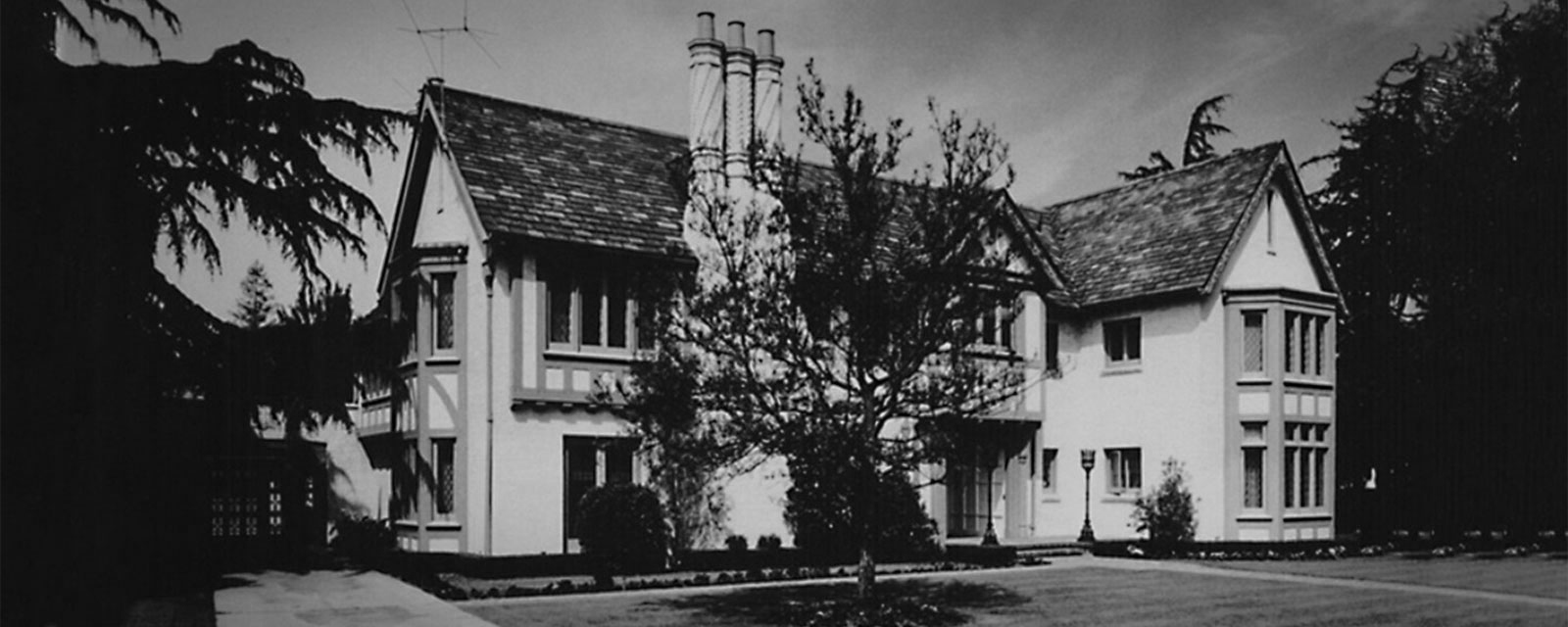The History of the Getty House and the Getty House Foundation
The English Tudor style house was built in 1921 by Swedish immigrants Leta and Paul Paulson who purchased an acre of land along the nearby, ever-growing Wilshire Boulevard, in Windsor Square. It was built by the same architects who designed the Egyptian and Chinese Theatres on Hollywood Boulevard. In 1928, Leslie Lockhart, president of the Rio Grande Oil Company, and his wife Jeanne, bought the house. They renovated giving the house a total of 19 rooms and purchased the lot behind their home for a tennis court.
In 1958 E.D. Buckley, an associate of Getty Oil Company, purchased the “Getty House property” from the Lockharts. The Getty Oil Company had intended to build their corporate headquarters in the area and purchased property on adjacent blocks, but a residential zoning ordinance prohibited such construction. In 1975, Getty Oil wrote a letter to the Los Angeles City Council offering the house as a gift for use as an official home for the Mayor of Los Angeles. On July 13, 1977 during the first term of Los Angeles’ 38th mayor, Tom Bradley, the house was officially dedicated as “Getty House, Official Residence of the Mayor of the City of Los Angeles.”
The Mayor, his wife Ethel, and their daughter moved into the house upon completion of the refurbishing in 1977 and lived there for 16 years. The house immediately became an important place to entertain visiting dignitaries. Just weeks after its dedication, Getty House was the site for a formal dinner welcoming the Prince of Wales, His Royal Highness Prince Charles. In attendance were city council members and Hollywood notable Gregory Peck. Mayor Bradley also served an important role in the 1984 Olympic Games, the acquisition of which he considered to be “the highlight of my entire political career.”
In many ways, Mayor Bradley’s position as the first mayoral occupant demonstrates the potential of Getty House to bridge people and interests. Bradley was the first African American elected mayor of Los Angeles, and the first mayor to reside in Getty House. Only decades before, in the 1940s, African Americans could not buy property in the exclusive neighborhoods of Hancock Park and Windsor Square. A former police chief, Bradley served as a coalition builder for the city during his five terms. He was one of Los Angeles’ most noted civic boosters, a role Getty House proudly continues today.
In 1993 Mayor Richard Riordan took office. While choosing to live in his personal residence, Riordan understood the importance of Getty House as a symbol of civic pride and a venue for special events and convenings. In 1993, the Getty House Restoration Foundation was established to raise funds for and oversee the refurbishment of Getty House. It supervised the repairs to the House following the 1994 Northridge earthquake.
In 1996, the foundation’s name was changed to the Getty House Foundation. Along with a new identity there was a redefined mission to focus on civics education, the preservation of the house, and community engagement; a focus that serves as the guiding principle to this day.
James K. Hahn took office as Los Angeles’ 40th mayor on July 1, 2001. Mayor Hahn continued his campaign to protect children and abate violence, causes begun during his tenure as city attorney. His dedication to children, youth, and their families is evident in his expansion and leadership of the after-school program, LA’s BEST.
In 2005, Antonio R. Villaraigosa became the city’s 41st mayor, and he and his family moved into Getty House. For the Villaraigosa administration, Getty House became a venue where community and city intersected. In addition to opening its doors to residents of Los Angeles, Getty House hosted renowned writer Carlos Fuentes, who was presented with the Key to the City in Spring 2006. Other notable visitors include New York Senator Hillary Clinton and Governor Emilio Gonzalez of Jalisco, Mexico.
In 2013, Eric Garcetti became the city’s 42nd mayor, and the third mayor to reside at Getty House with his family. The Foundation, in conjunction with Mayor Garcetti and his wife Amy Wakeland, developed new programs and outreach initiatives, including the Community Holiday Series, the Engage LA Series, and the Women’s Leadership Series.
With the election of Congresswoman Karen Bass as the city’s 43rd mayor in 2022, the Foundation, in conjunction with Mayor Bass, continues the tradition of developing programs and initiatives that celebrate our city’s rich diversity, foster public-private partnerships, and promote civic engagement. The Foundation’s new Event Series include International LA, Strategic LA, and Lock Arms LA!
In summary, the Getty House and the Getty House Foundation serve as a hub for community engagement, cultural enrichment, education, and public service, with the aim of creating a stronger, more vibrant Los Angeles for all.
